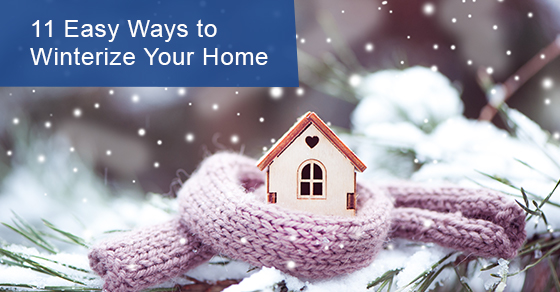11 Easy Ways to Winterize Your Home
Canada is known for its cold winters, with Arctic winds coming in from the north, heavy snow, and ice storms all posing risks for your home. Although climate change has altered the severity of the cold, it certainly hasn’t done much to reduce the rain, frost, and wind. All of these elements can interfere with the warmth and comfort of your house. If you want to stay snug as a bug this winter, here are 11 easy ways to winterize your home. You’ll keep warm and see a reduction in your energy bills too!
1. Insulate your attic
Although most homes have insulation in the attic, when and how it was insulated, in hand with the type of insulation, all impact its effectiveness. While the EPA says attics should have a minimum of R-38 insulation, most homes don’t have close to enough. To properly insulate your attic, you should look at the attic floor where proper insulation can prevent the heat from below from escaping into the attic and right out the roof. You should also caulk common areas in the attic that can contribute to heat loss including cracks and gaps around wires, ducts, and pipes. You can also place an insulating cover over the entry to the attic.
2. Add caulking
While you’ve got the caulking gun out for the attic, go through your entire house and look for cracks and gaps that can allow cold air to enter your home. This includes:
- Window frames
- Door frames
- Pipes
- Outlets
- Exterior gaps and cracks
A high-quality acrylic-latex caulk works well for smaller gaps, while an expanding-foam sealant is best for larger gaps. Do both the exterior and interior of your house, paying special attention to the area where the siding overlaps your foundation. Be certain you are using the proper caulking designed for exterior and interior use.
3. Install storm windows
Older homes with old windows can benefit from storm windows. Single-pane windows are notorious for drafts. Storm windows can be placed on the exterior of your home. However, if budget allows, you might want to consider installing energy-efficient windows. You can also consider using a clear plastic wrap product that is applied to the interior of the windows. Just keep in mind that if you like to open your windows in the winter, you won’t be able to do so with the window insulation.
4. Replace or install weather stripping
The weather stripping on your exterior doors might not look like much, but it provides added protection from the cold. If your weather stripping is damaged with rips, or is flattened out with age, it should be replaced. Put your hand up to the door to feel for drafts if you aren’t sure if your weather stripping is failing. You can also look to see if light is coming through the gap between the door and frame.
5. Install a door sweep
Door sweeps are another good insulating addition. They are installed at the bottom of the door to prevent cold air from creeping in over the threshold, while helping keep warm air inside.
6. Add new furnace filters
Dirty furnace filters can interfere with airflow, and reduce your furnace’s energy efficiency. Always change your furnace filters in the fall, and then check them every month throughout the winter.
7. Install a smart thermostat
Smart thermostats can make a world of difference to both your home comfort and energy bills. These programmable thermostats allow you to set a schedule based on the average comings and goings of your family. They can be programmed to reduce temperatures while everyone is away at school and work, and then to rise just before everyone gets home so your house is nice and warm. You can also set lower temperatures at bedtime, and have the temperature rise in the morning. In fact, you can even have it programmed based on the days of the week, so weekends your home remains warm during the day. You also get cool tools that allow you to monitor usage, make adjustments from your phone or tablet, tie your system in with other
smart home systems, and more.
8. Use electrical outlet gaskets
There can be significant heat loss through the dozens of electrical outlets and light switches throughout your home. You can buy outlet gaskets at your local home renovation center and install them easily. They are made of foam-rubber that is cut to size for your outlets. You just have to remove the cover plates, add the gasket, and put the cover back on.
9. Switch your ceiling fan direction
During the summer, your ceiling fans run counterclockwise to blow cool air downwards. However, most people don’t realize they can reverse the direction to clockwise in the winter. This allows the ceiling fan to carry the warm air trapped at the ceiling back down into the room.
10. Invest in insulated window treatments
Insulated window treatments are available in a wide variety of sizes and designs. When closed, they help keep warm air from escaping out the windows, so rooms stay toasty.
11. Insulate your hot-water pipes
When water has to travel through cold pipes to get to your shower and sinks, it tends to cool down by the time it reaches you. If you insulate your hot water pipes, the water stays warm, and you can set the water heater temperature a little lower. You don’t waste time “running the water” waiting for it to heat up, and you can take a hot shower or bath without that initial chill. You can easily install either foam-rubber sleeves or insulated wraps to your hot water pipes. This also reduces risk for burns. A poorly insulated home is not only colder, but can also increase risk for winter issues including
leaking roofs, burst pipes, and more. Make sure you have the proper
home insurance that Ottawa homeowners need to cover winter-related incidents. For more information,
speak to our team at Oegema, Nicholson & Associates Insurance Brokers today.


